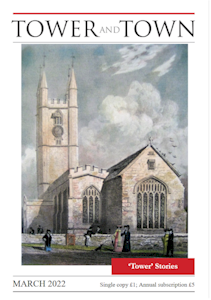

Tower and Town, March 2022 (view the full edition) (view the full edition)The Catholic Community in MarlboroughAs far as I know, there are only two places in the world where the Catholic Faith has begun in a stable. Well, yes, you've got the first one. That was pretty easy, but what about the second? Give up? The answer's simple. In the inter-war era, a stable on the Manton Estate was converted into a chapel for the Irish stable lads, who would otherwise have to go to Swindon or Devizes to attend mass. In 1937, Marlborough got its own priest for the first time since the Reformation when the Salesian fathers opened a chapel in the presbytery in Elcot Lane. It was not until 1947 that a humble Nissen hut in George Lane became the place of worship, but the history of Catholicism in Wiltshire goes back long before that. Sometime around 909, St. Oda the Good was consecrated Bishop of Ramsbury. The scattered rural community of Marlborough would have been part of his Cura Animarum. The four churches of the Marlborough Anglican parishes all date from the Middle Ages when two thriving monastic communities were established here: the Gilbertine Canons, probably endowed by King Henry II, built St Margaret's Priory, and the Carmelite Friars also established a religious house. Yet, at the Reformation all this was swept away. In 1594 it was reported that there were only two papists in the borough, but this wasn't exactly a time when Catholics would declare their faith publicly. The Hyde family at the Hermitage in the lane that bears their name had a resident Benedictine chaplain. In 1778, James White, landlord of the noted Castle Inn, was also identified as a Catholic recusant. There was still a great deal of anti-Catholic sentiment in the area, however. The Marquis of Ailesbury was a fervent opponent of the Duke of Wellington's Catholic Emancipation Bill of 1829 and presented a petition to Parliament against it from the Marlborough Corporation. With the passing of the Act, it became possible for Catholics to build their own churches, but it was not till 1959 that the church of St. Thomas More was built on the George Lane site. As is appropriate for a church which can claim to be represented in virtually all the nations of the world, the community of St Thomas More enjoys within its fold people of a number of different nationalities. Many of the storms of the past are over, although the Catholic faith continues to present a challenge to those aspects of contemporary society that fall short of Christian values. Nick Fogg |